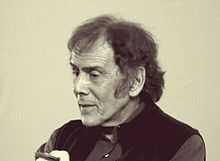David Manzur

David Manzur Londoño (born December 14, 1929) is a Colombian painter and two-time Guggenheim Fellowship recipient. His subjects include still lifes, mounted knights, and saints.[1]
Early life and education
Manzur was born in Neira, Caldas, Colombia. His father, Salomón Manzur, was a Lebanese businessman; his mother, Cecilia Londoño Botero, was Colombian.[2] He spent his childhood and adolescence in Bata, Equatorial Guinea, in the Canary Islands, and in Seville, living through the Spanish Civil War and World War II in Africa and Europe.[3]
After returning to Colombia in 1947, he settled in Bogotá, where he began to study art, music, and acting. He had a brief theatrical career.[3] He studied art at the School of Fine Arts in Bogotá and at the Art Students League and Pratt Institute in New York, and received two consecutive Guggenheim Fellowships and a fellowship from the Organization of American States.[3]
While in the United States, he was assistant to Naum Gabo, the Russian Constructivist sculptor and pioneer of Kineticism.[4]
Career
On returning to Colombia he founded an art workshop that was in existence for more than 20 years and trained many artists.[2] He had his first solo exhibition at the Colombian National Museum when he was 24, featuring figurative works.[5] During the 1960s and 1970s, Constructivism was an important part of his work, and he produced mostly abstract works and experimented with materials such as wood, thread, and wire.[2][4]
Influenced by Spanish Baroque art, in particular by painters such as Velázquez, Zurbarán, and Sanchez Cotán, and using elements drawn from the 19th-century American realists William Harnett and John F. Peto, Manzur returned to figurative art, painting still lifes, the ecstasy of St. Teresa, the story of St. Sebastian, and especially horses in various situations. These works brought him wide recognition.[6]
In recent years Manzur has turned to new subjects.[1] The Ciudades Oxidadas (rusted cities) series, which he exhibited in the first decade of the 21st century, showed his special interest in the deterioration of the planet and was the result of extensive travel and research.[7] His most recent show, Obra Negra (dark work), represents a radical break with his previous techniques.[8] He now spends most of his time at his studio in Barichara, Santander.[9]
Awards
- 1961: Guggenheim Fellowship, Guggenheim Foundation
- 1962: Guggenheim Fellowship, Guggenheim Foundation
- 1964: Pratt Institute scholarship, Organization of American States
- Prize, 1st INTERCOL salon for young artists, Bogotá Museum of Modern Art
- 1970: First Prize, Government of Antioquia, 2nd COLTEJER Biennial, Medellín
- 2005: Order of the Congress of the Republic of Colombia
References
- ↑ 1.0 1.1 Fernando Gómez, "Manzur, el clásico", Semana, June 25, 2001 (Spanish).
- ↑ 2.0 2.1 2.2 Camilo Chico and María Elvira Ardila, "Cronologia". Bogotá Museum of Modern Art.
- ↑ 3.0 3.1 3.2 José Gómez-Sicre, Department of Visual Arts, Department of Cultural Affairs of the Organization of American States, 1977.
- ↑ 4.0 4.1 Eduardo Serrano, Manzur: Homenaje, Bogotá: Villegas, 2005, ISBN 9789588156477 (Spanish).
- ↑ Germán Rubiano, Obra Negra, Galerie La Cometa, 2014 (Spanish).
- ↑ "Manzur", Mundo 12 (2003).
- ↑ Margarita Vidal, "David Manzur: 'El día que quede contento con un cuadro, no vuelvo a pintar'", Credencial, January 10, 2012 (Spanish).
- ↑ Juan David Zuloaga D. and Lorenzo Acosta Valencia, "David Manzur habla sobre su trabajo y su vida: 'Mi obra termina cuando yo muera'", El Espectador, January 17, 2015 (Spanish).
- ↑ "Un pintor de lo esencial", La Vanguardia, January 10, 2015 (Spanish).
External links
 Media related to David Manzur at Wikimedia Commons
Media related to David Manzur at Wikimedia Commons- Gallery La Cometa (Bogotá, Colombia)
- Gallery Duque Arango (Medellín, Colombia)